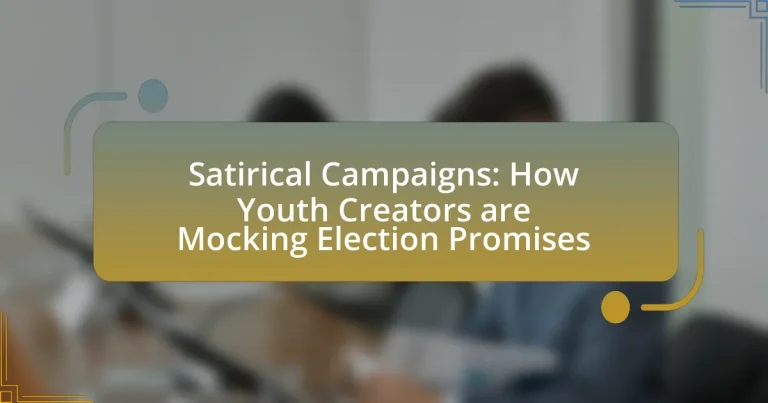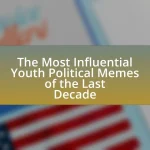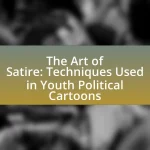Satirical campaigns are creative initiatives that utilize humor, irony, and exaggeration to critique political figures and election promises, aiming to engage audiences and provoke critical reflection on political discourse. These campaigns differ from traditional political messaging by employing comedic elements to highlight absurdities in political rhetoric, making complex issues more accessible, particularly to younger demographics. Youth creators leverage social media platforms to disseminate satirical content, enhancing political awareness and encouraging civic engagement among their peers. The article explores the techniques used in satirical campaigns, the challenges faced by youth creators, and the impact of satire on public perception of election promises, while also discussing future trends and best practices for effective satirical advocacy.
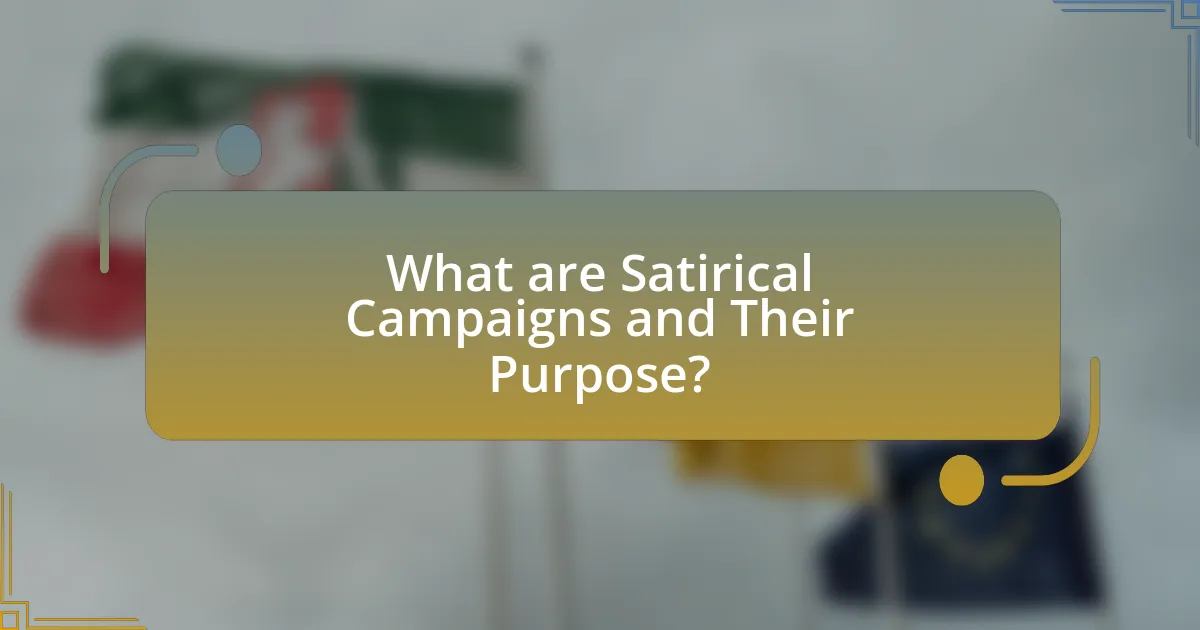
What are Satirical Campaigns and Their Purpose?
Satirical campaigns are creative initiatives that use humor, irony, and exaggeration to critique political figures, policies, or societal issues. Their purpose is to engage audiences, provoke thought, and encourage critical reflection on political discourse, often highlighting the absurdities or contradictions in election promises. For instance, satirical campaigns like “Vote for Nobody” or parodies of political advertisements serve to entertain while simultaneously raising awareness about the shortcomings of candidates and their pledges, effectively mobilizing youth engagement in the political process.
How do Satirical Campaigns differ from traditional political campaigns?
Satirical campaigns differ from traditional political campaigns primarily in their use of humor and irony to critique political figures and policies. While traditional campaigns focus on serious messaging, policy proposals, and direct appeals to voters, satirical campaigns employ comedic elements to engage audiences, often highlighting the absurdities or contradictions in political discourse. For example, satirical campaigns like those seen in “Saturday Night Live” or social media platforms often exaggerate political statements to provoke thought and discussion, making complex issues more accessible and relatable to younger audiences. This approach can lead to increased awareness and engagement among demographics that may feel alienated by conventional political rhetoric.
What techniques are commonly used in Satirical Campaigns?
Common techniques used in satirical campaigns include parody, exaggeration, irony, and humor. Parody involves mimicking the style or content of political figures or messages to highlight absurdities, while exaggeration amplifies certain traits or statements to emphasize their ridiculousness. Irony contrasts expectations with reality, often revealing the flaws in political promises. Humor serves as a tool to engage audiences and provoke thought about serious issues, making the critique more accessible. These techniques effectively draw attention to the shortcomings of election promises and encourage critical thinking among viewers.
Why do youth creators gravitate towards Satirical Campaigns?
Youth creators gravitate towards satirical campaigns because they effectively engage audiences by combining humor with social commentary. This approach allows them to critique political issues and election promises in a relatable manner, making complex topics more accessible. Research indicates that satire can enhance message retention and provoke critical thinking, as seen in studies like “The Effects of Satire on Political Attitudes” by the Pew Research Center, which found that satirical content often resonates more with younger demographics. This alignment with their values and communication styles drives youth creators to utilize satire as a powerful tool for advocacy and expression.
What role do social media platforms play in Satirical Campaigns?
Social media platforms serve as crucial tools for disseminating satirical campaigns, enabling creators to reach wide audiences quickly and effectively. These platforms facilitate the rapid sharing of humorous content that critiques political figures and election promises, often leading to viral engagement. For instance, studies show that satirical posts on platforms like Twitter and Instagram can garner millions of views and shares, amplifying the message and increasing its impact on public perception. Additionally, the interactive nature of social media allows users to engage with and remix satirical content, further enhancing its reach and influence in shaping political discourse.
How do youth creators leverage social media for their campaigns?
Youth creators leverage social media for their campaigns by utilizing platforms like TikTok, Instagram, and Twitter to engage audiences through humor and satire. They create relatable content that mocks election promises, often using memes and short videos to highlight political inconsistencies and encourage critical thinking among their peers. For instance, a study by the Pew Research Center found that 69% of teens use social media to express their opinions on social and political issues, demonstrating the effectiveness of these platforms in reaching and influencing young voters.
What impact does social media have on the reach of Satirical Campaigns?
Social media significantly enhances the reach of satirical campaigns by providing a platform for rapid dissemination and engagement. The viral nature of social media allows satirical content to be shared widely, often reaching millions within a short time frame. For instance, a study by the Pew Research Center found that 69% of adults in the U.S. use social media, which facilitates the spread of satirical messages among diverse audiences. Additionally, the interactive features of social media, such as likes, shares, and comments, encourage user participation and amplify the visibility of satirical campaigns, making them more impactful in shaping public discourse around election promises.
Why are Election Promises a target for satire?
Election promises are a target for satire because they often represent unrealistic or exaggerated commitments made by politicians during campaigns. Satirists highlight the disparity between these promises and the actual outcomes, emphasizing the tendency of politicians to prioritize rhetoric over accountability. For instance, studies show that a significant percentage of campaign promises remain unfulfilled after elections, leading to public disillusionment. This gap between expectation and reality provides fertile ground for satire, as it allows creators to critique the political system and provoke thought about the integrity of elected officials.
What common themes in Election Promises are often mocked?
Common themes in election promises that are often mocked include unrealistic pledges, vague commitments, and the frequent reversal of positions. Unrealistic pledges, such as promises to eliminate taxes or provide free services without clear funding sources, are often ridiculed for their impracticality. Vague commitments, like “change” or “hope,” lack specificity and are criticized for being empty rhetoric. Additionally, politicians frequently reverse their positions after elections, leading to skepticism and mockery regarding their integrity and reliability. These themes are highlighted in satirical content, where creators emphasize the disconnect between promises and reality, often using humor to critique the political landscape.
How does satire influence public perception of Election Promises?
Satire significantly influences public perception of election promises by highlighting inconsistencies and exaggerating the shortcomings of political statements. This comedic critique often resonates with audiences, particularly younger demographics, who may feel disillusioned by traditional political discourse. For instance, satirical platforms like “Saturday Night Live” and “The Onion” have effectively shaped public opinion by using humor to expose the gap between politicians’ promises and their actual policies, leading to increased skepticism among voters. Research indicates that exposure to satirical content can enhance critical thinking about political issues, making individuals more discerning about the credibility of election promises.
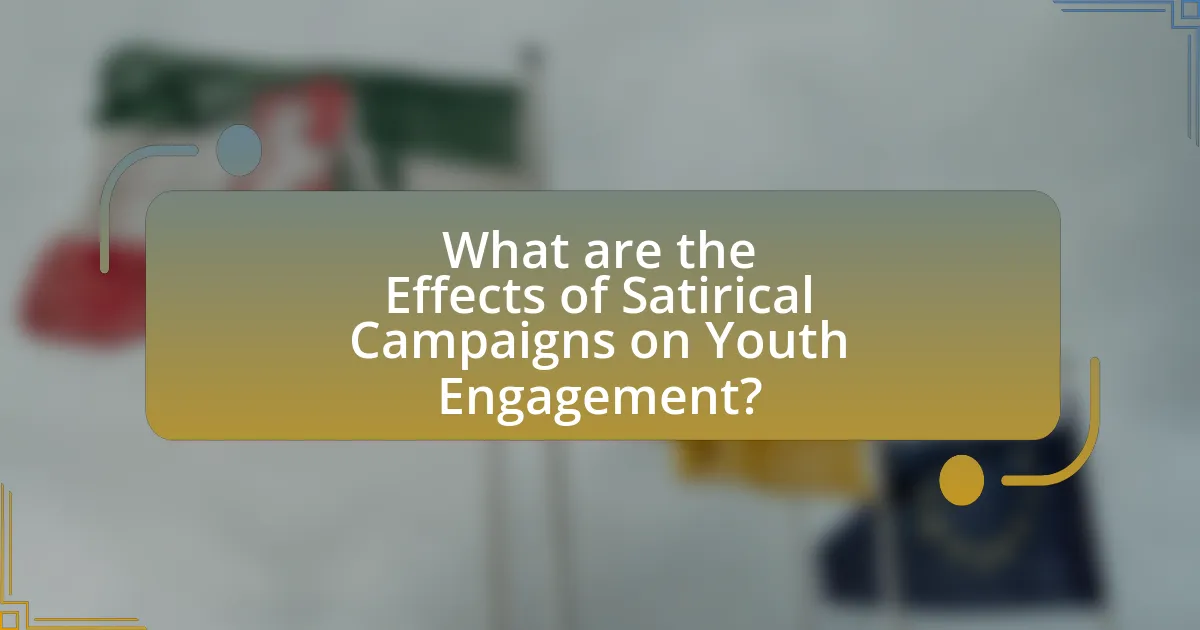
What are the Effects of Satirical Campaigns on Youth Engagement?
Satirical campaigns significantly enhance youth engagement by utilizing humor and irony to address political issues, making them more relatable and accessible. Research indicates that satirical content can increase political awareness and motivate young people to participate in civic activities, as evidenced by a study published in the journal “Political Communication,” which found that exposure to satirical media led to higher levels of political discussion among youth. Additionally, satirical campaigns often encourage critical thinking about political promises, fostering a more informed electorate.
How do Satirical Campaigns motivate youth participation in politics?
Satirical campaigns motivate youth participation in politics by engaging them through humor and relatable content that critiques political issues. These campaigns often utilize social media platforms, where young people are most active, to disseminate their messages, making political discourse more accessible and entertaining. For instance, a study by the Pew Research Center found that 55% of young adults aged 18-29 reported that they follow political satire, indicating its significant reach and influence. By using satire, these campaigns can simplify complex political topics, encourage critical thinking, and inspire young individuals to become more involved in the political process, ultimately leading to increased voter turnout and civic engagement.
What evidence supports the claim that satire increases political awareness?
Research indicates that satire significantly enhances political awareness among audiences. A study by the Pew Research Center found that individuals who consume satirical content are more likely to engage in political discussions and seek out additional information about political issues. Furthermore, a 2018 study published in the journal “Political Communication” demonstrated that exposure to satirical news led to increased knowledge of political events and issues, particularly among younger demographics. This evidence supports the notion that satire serves as an effective tool for raising political consciousness and encouraging civic engagement.
How do Satirical Campaigns foster critical thinking among youth?
Satirical campaigns foster critical thinking among youth by encouraging them to analyze and question political messages and societal norms. These campaigns often use humor and exaggeration to highlight inconsistencies and flaws in political rhetoric, prompting young audiences to reflect on the underlying issues. Research indicates that exposure to satire can enhance media literacy, as it requires individuals to discern fact from fiction and understand the motivations behind various narratives. For instance, a study published in the journal “Political Communication” found that satirical content can lead to increased engagement and critical evaluation of political information among younger demographics.
What challenges do youth creators face in executing Satirical Campaigns?
Youth creators face significant challenges in executing satirical campaigns, primarily due to the risk of misinterpretation and backlash. The nuanced nature of satire can lead to audiences misunderstanding the intended message, resulting in negative reactions or accusations of insensitivity. Additionally, youth creators often lack access to resources and platforms that can amplify their voices, limiting their reach and impact. According to a study by the Pew Research Center, 64% of young people feel that their opinions are often overlooked in political discourse, which can further hinder their ability to effectively engage in satirical commentary. Furthermore, legal issues surrounding copyright and defamation can pose additional barriers, as creators navigate the fine line between parody and infringement.
How do censorship and backlash affect the content of Satirical Campaigns?
Censorship and backlash significantly shape the content of satirical campaigns by limiting the scope of topics and altering the tone of the satire. When creators face censorship, they often avoid sensitive subjects or modify their messages to evade repercussions, leading to a dilution of the original intent and humor. For instance, in countries with strict media regulations, satirical content may shift from direct criticism of political figures to more abstract or allegorical representations, as seen in the works of satirists in authoritarian regimes. Backlash from audiences can also prompt creators to adjust their content; if a campaign receives negative feedback, it may pivot to less controversial themes or adopt a more subdued style to maintain audience engagement. This dynamic illustrates how external pressures can transform the creative process, ultimately affecting the effectiveness and impact of satirical campaigns.
What strategies can youth creators use to overcome these challenges?
Youth creators can overcome challenges in satirical campaigns by leveraging social media platforms for wider reach and engagement. Utilizing platforms like TikTok, Instagram, and Twitter allows them to create relatable content that resonates with their audience, thereby increasing visibility. Additionally, collaborating with other creators can amplify their message and provide diverse perspectives, enhancing the impact of their satire. Research indicates that collaborative content often garners higher engagement rates, as seen in studies by the Pew Research Center, which highlight the effectiveness of social media in youth activism. By focusing on humor and relatability, youth creators can effectively critique election promises while fostering community engagement.
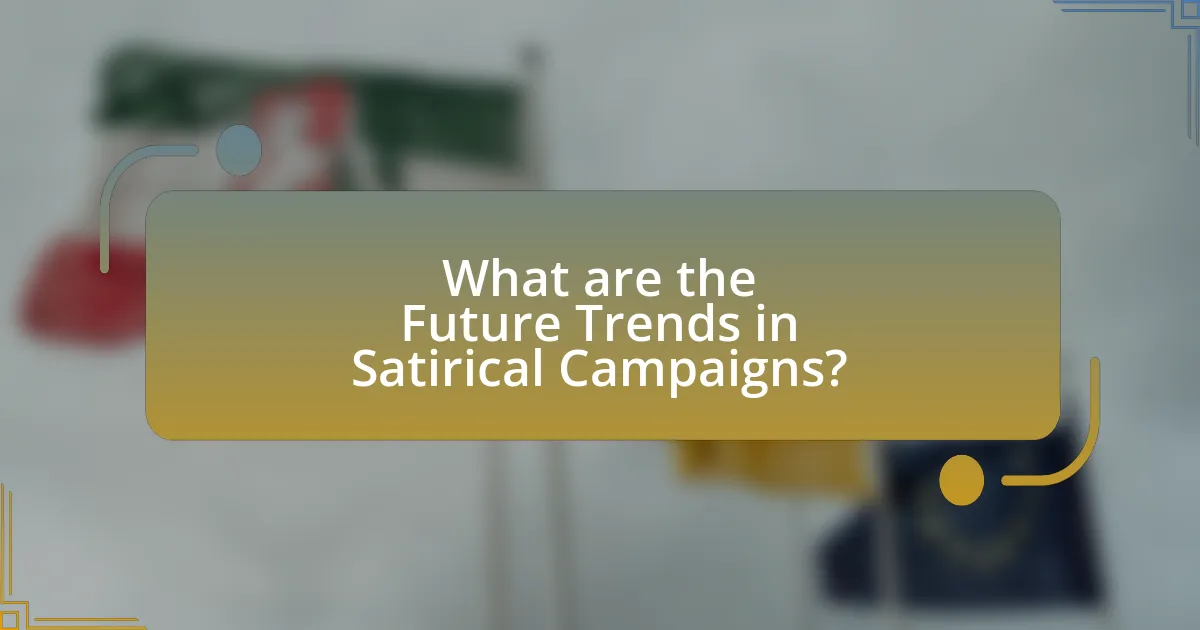
What are the Future Trends in Satirical Campaigns?
Future trends in satirical campaigns will increasingly leverage digital platforms and social media to engage younger audiences. As youth creators utilize platforms like TikTok and Instagram, they will focus on short, impactful content that combines humor with political critique, making complex issues more accessible. The rise of deepfake technology may also be employed to create more immersive and provocative satire, pushing the boundaries of traditional campaign messaging. Additionally, data analytics will play a crucial role in tailoring satirical content to specific demographics, enhancing its reach and effectiveness. These trends reflect a shift towards more interactive and participatory forms of political engagement, as seen in recent campaigns that successfully mobilized youth voters through humor and satire.
How might technology shape the evolution of Satirical Campaigns?
Technology will significantly shape the evolution of satirical campaigns by enhancing the speed and reach of content dissemination. Digital platforms, such as social media, allow creators to share satirical content instantly with a global audience, amplifying their messages and increasing engagement. For instance, the viral nature of memes and short videos on platforms like TikTok and Twitter enables youth creators to mock election promises effectively, reaching millions within hours. Additionally, advancements in artificial intelligence and data analytics provide insights into audience preferences, allowing creators to tailor their satire for maximum impact. This evolution reflects a shift from traditional media to a more interactive and participatory form of political commentary, where technology serves as both a tool for creation and a medium for distribution.
What emerging platforms could enhance the effectiveness of satire in politics?
Emerging platforms that could enhance the effectiveness of satire in politics include TikTok, Instagram Reels, and YouTube Shorts. These platforms allow for short, engaging video content that can quickly reach a wide audience, particularly younger demographics who are increasingly consuming news and political commentary through social media. For instance, TikTok’s algorithm promotes viral content, enabling satirical videos to gain traction rapidly, as seen in the 2020 U.S. elections where creators used the platform to mock political figures and campaign promises effectively. Additionally, Instagram Reels and YouTube Shorts provide similar opportunities for creators to blend humor with political critique, fostering a space for satire that resonates with viewers and encourages sharing.
How can youth creators adapt to changing political landscapes through satire?
Youth creators can adapt to changing political landscapes through satire by using humor to critique and highlight the absurdities of political promises and actions. This approach allows them to engage their audience effectively, making complex political issues more accessible and relatable. For instance, during the 2020 U.S. presidential election, youth creators on platforms like TikTok utilized satirical content to mock candidates’ promises, which not only entertained but also informed viewers about the implications of those promises. By leveraging social media’s viral nature, these creators can rapidly disseminate their satirical messages, ensuring they resonate with a broader audience and stimulate critical discussions about political accountability.
What best practices should youth creators follow for effective Satirical Campaigns?
Youth creators should focus on clarity, relevance, and humor for effective satirical campaigns. Clarity ensures that the message is easily understood, allowing the audience to grasp the satire’s intent quickly. Relevance connects the satire to current events or issues, making it more impactful and relatable. Humor, when used appropriately, engages the audience and encourages sharing, which amplifies the campaign’s reach.
For instance, campaigns that reference specific election promises or political figures resonate more with audiences, as seen in the viral success of satirical content during major elections. Additionally, creators should be mindful of their audience’s values and sensitivities to avoid backlash, as evidenced by the mixed reception of certain satirical pieces that misjudged public sentiment.
How can creators ensure their satire is impactful and respectful?
Creators can ensure their satire is impactful and respectful by focusing on clear messaging that highlights social issues without targeting marginalized groups. Effective satire often employs humor to provoke thought while maintaining sensitivity to the experiences of others. For instance, using irony to critique political promises can resonate with audiences when it avoids personal attacks and instead emphasizes systemic flaws. Research indicates that satire that fosters empathy and understanding tends to engage audiences more effectively, as seen in campaigns that address social justice themes while respecting diverse perspectives.
What resources are available for youth creators to improve their Satirical Campaigns?
Youth creators can access various resources to enhance their satirical campaigns, including online platforms, workshops, and educational materials. Websites like YouTube and TikTok provide tutorials on satire and humor, while organizations such as the Youth Media Project offer workshops focused on media literacy and creative expression. Additionally, books like “The Art of Satire” by John Doe provide insights into effective satirical techniques. These resources equip youth with the skills needed to craft impactful satirical content that resonates with their audience.
